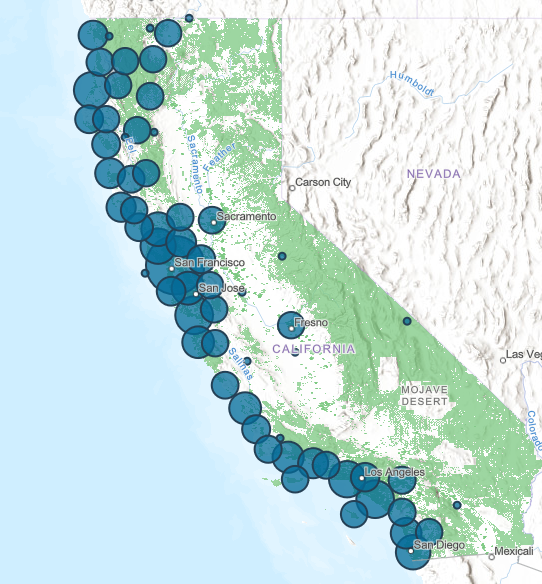Press Release: New Legislation Gives Coastal Conservancy New Tools to Prepare California for Climate Change
Governor signs bills to establish Climate Ready grant program in statute and prioritize natural infrastructure to prepare the coast for climate change
Oakland, CA – Today, the California State Coastal Conservancy welcomed Governor Newsom’s signatures on AB 65 (Petrie-Norris) and SB 576 (Umberg), two pieces of legislation that will give the State of California new tools to prepare for, and combat, the impacts of climate change.
The two bills amend Section 31113 of the Public Resources Code to:
- Establish the Coastal Conservancy’s Climate Ready grant program in statute.
- Define “natural infrastructure” in the Public Resources Code.
- Instruct the Coastal Conservancy to prioritize projects that use natural infrastructure and provide multiple public benefits when allocating Proposition 68 climate funds.
“California has long been a leader in understanding the reality of a changing climate. Today’s legislation shows that we will also lead the way in implementing adaptation strategies that give long-term protection to coastal communities while preserving natural resources.” said Sam Schuchat, Executive Officer of the Coastal Conservancy. “By securing our Climate Ready program in statute, and prioritizing multi-benefit projects that use natural infrastructure, the Governor and Legislature have equipped us to better help California prepare for climate change through projects that use nature to provide flood protection, reduce coastal erosion, and increase public access to the coast.”
Natural Infrastructure refers to the use of natural ecological systems or processes to reduce vulnerability to climate change related hazards, in contrast to “grey” infrastructure which uses manufactured solutions, such as sea walls or riprap.
The Conservancy initiated its Climate Ready grant program six years ago to implement projects that reduce greenhouse gas emissions and help coastal communities prepare for the the impacts of climate change. Climate Ready projects are building greener and cooler parks in urban areas, improving farm management practices to conserve water and sequester carbon, and utilizing natural habitat to protect shorelines. Demand for state funding and technical assistance to implement these projects, however, has far outpaced the Conservancy’s current capacity; in the five Climate Ready grant rounds the Conservancy received over 200 proposals requesting $50 million but has only been able to award $10 million to 57 projects.
“With Climate Ready as a permanent grant program at the Conservancy, we can start considering year-on-year funding for projects and expand the scope of this very important funding source.” Schuchat continued, “Preparing for climate change is a race against time but we must be careful not to lose the character of our coast in the rush to protect it; with these thoughtful changes to the Public Resource Code, the State of California is charting a course to retain beaches, wetlands, bluffs and estuaries for generations to come.”
Notes to Editors:
The Coastal Conservancy is a state agency, established in 1976, to protect and improve natural lands and waterways, to help people get to and enjoy the outdoors, and to sustain local economies along California’s coast. The Conservancy is a non-regulatory agency that supports projects to protect coastal resources and increase opportunities for the public to enjoy the coast.
Since its founding, the Conservancy has:
- Funded 2,400 projects along the California coastline and in the San Francisco Bay.
- Protected 390,000 acres of coastal lands through acquisition of fee title and conservation easements.
- Restored 33,000 acres of habitat.
- Built 200 new coastal accessway and 210 miles of new trails.
- Put $1.3 billion to work for conservation projects, and leveraged far more from federal, local government, and private sources.
AB 65 and SB 576 amend Section 31113 of the Public Resources Code to read:
31113.
(a) The Climate Ready Program is hereby established and shall be administered by the conservancy to address the impacts and potential impacts of climate change on resources within the conservancy’s jurisdiction.
(b) In implementing this division, the conservancy may undertake projects within its jurisdiction, including, but not limited to, those that reduce greenhouse gas emissions, address extreme weather events, sea level rise, storm surge, beach and bluff erosion, salt water intrusion, flooding, and other coastal hazards that threaten coastal communities, infrastructure, and natural resources.
(c) Pursuant to the Climate Ready Program, the conservancy may award grants to public agencies and nonprofit organizations for activities authorized pursuant to subdivision (b). In awarding the grants, the conservancy shall, to the extent allowed, prioritize projects that maximize public benefits and that accomplish either of the following:
(1) Reduce emissions of greenhouse gases, reduce hazards to harbors and ports, preserve and enhance coastal wetlands and natural lands, conserve biodiversity, and provide recreational opportunities.
(2) Reduce flood risk and enhance fish and wildlife habitat, including projects with multiple benefits that remove sediment where the excavated material can be used to enhance shorelines or ecosystems.
(d) (1) When allocating funds made available pursuant to Section 80133, the conservancy shall do all of the following:
(A) Prioritize projects that use natural infrastructure in coastal communities to help adapt to climate change.
(B) Prioritize projects that provide multiple public benefits, including, but not limited to, protection of communities, natural resources, and recreational opportunities.
(C) Give consideration to projects in a variety of ecosystems along the state’s coastline, including, but not limited to, the protection and expansion of coastal estuaries and lagoons that provide critical feeding and nursery habitat for juvenile fish species and foraging habitat for migratory waterfowl and other waterbirds, including eelgrass habitat.
(2) The conservancy shall provide information to the Office of Planning and Research on any projects funded pursuant to this subdivision to be considered for inclusion into the clearinghouse for climate adaption information, established pursuant to Section 71360.
(3) The conservancy may provide technical assistance to coastal communities to better assist them with their projects that use natural infrastructure.
(4) For purposes of this subdivision, “natural infrastructure” means using natural ecological systems or processes to reduce vulnerability to climate change related hazards, or other related climate change effects, while increasing the long-term adaptive capacity of coastal and inland areas by perpetuating or restoring ecosystem services. This includes, but is not limited to, the conservation, preservation, or sustainable management of any form of aquatic or terrestrial vegetated open space, such as beaches, dunes, tidal marshes, reefs, seagrass, parks, rain gardens, and urban tree canopies. It also includes systems and practices that use or mimic natural processes, such as permeable pavements, bioswales, and other engineered systems, such as levees that are combined with restored natural systems, to provide clean water, conserve ecosystem values and functions, and provide a wide array of benefits to people and wildlife.
Latest News
- Job Posting: Project Support AnalystLove the North Coast, the San Francisco Bay Area, and the environment? This might be the job for you! The State Coastal Conservancy has two exciting opportunities for you to join us in protecting California’s iconic lands and waters, restoring vital habitats, and increasing inclusive and equitable enjoyment of the coast and shoreline. The Conservancy […] (Read more on Job Posting: Project...)
- Press Release: Coastal Conservancy Awards over $40 million for coastal access, restoration, and climate resilienceOakland, CA (4/18/2024) – Today, the Board of the State Coastal Conservancy approved grants totaling over $40 million for coastal access, restoration, and climate resilience. Among the grants awarded today are: A grant of up to $6,000,000 to Humboldt County Resource Conservation District to undertake the North Coast Wildfire Resilience Planning and Implementation Grant Program, which […] (Read more on Press Release: Coastal...)
- Sea Otter Recovery Grants RFP Now Open!The California State Coastal Conservancy announces the availability of grants to public agencies, tribes and nonprofit organizations for projects that facilitate the recovery of the southern sea otter along California’s coasts. The California Sea Otter Fund is one of the state’s tax check-off funds that allows taxpayers to voluntarily contribute to the recovery of California’s […] (Read more on Sea Otter Recovery...)

 Help Save Sea Otters at Tax Time
Help Save Sea Otters at Tax Time

